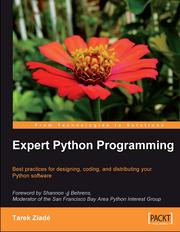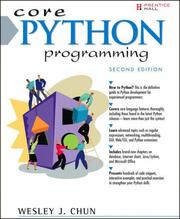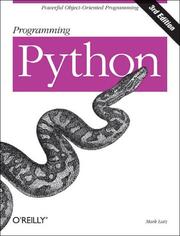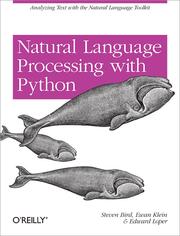| Listing 1 - 10 of 10 |
Sort by
|

ISBN: 9781847194947 9781847194954 1847194958 184719494X 1281788554 9781281788559 9786611788551 6611788557 Year: 2009 Publisher: Birmingham ; Mumbai : Packt Publishing,
Abstract | Keywords | Export | Availability | Bookmark
 Loading...
Loading...Choose an application
- Reference Manager
- EndNote
- RefWorks (Direct export to RefWorks)
Book
ISBN: 9789461754158 Year: 2016 Publisher: Etten-Leur Corona
Abstract | Keywords | Export | Availability | Bookmark
 Loading...
Loading...Choose an application
- Reference Manager
- EndNote
- RefWorks (Direct export to RefWorks)
Programmeren --- Python (programmeertaal) --- Scratch (software)

ISBN: 9780132269933 0132269937 Year: 2007 Publisher: Upper Saddle River, NJ London : Prentice Hall,
Abstract | Keywords | Export | Availability | Bookmark
 Loading...
Loading...Choose an application
- Reference Manager
- EndNote
- RefWorks (Direct export to RefWorks)

ISBN: 9780596009250 0596009259 Year: 2008 Publisher: Sebastopol, CA : O'Reilly,
Abstract | Keywords | Export | Availability | Bookmark
 Loading...
Loading...Choose an application
- Reference Manager
- EndNote
- RefWorks (Direct export to RefWorks)
Book
ISBN: 9781590282571 1590282574 Year: 2011 Publisher: Sherwood, Or. : Franklin, Beedle & Associates,
Abstract | Keywords | Export | Availability | Bookmark
 Loading...
Loading...Choose an application
- Reference Manager
- EndNote
- RefWorks (Direct export to RefWorks)
This textbook is about computer science. It is also about Python. However, there is much more. The study of algorithms and data structures is central to understanding what computer science is all about. Learning computer science is not unlike learning any other type of difficult subject matter.
Python (Computer program language) --- Computer algorithms. --- Data structures (Computer science) --- Algoritmen --- Datastructuren --- Python (programmeertaal) --- Datoralgoritmer. --- Datastrukturer.
Book
ISBN: 9781492072942 Year: 2017 Publisher: Sebastopol, CA : O'Reilly,
Abstract | Keywords | Export | Availability | Bookmark
 Loading...
Loading...Choose an application
- Reference Manager
- EndNote
- RefWorks (Direct export to RefWorks)
Statistical methods are a key part of of data science, yet very few data scientists have any formal statistics training. Courses and books on basic statistics rarely cover the topic from a data science perspective. This practical guide explains how to apply various statistical methods to data science, tells you how to avoid their misuse, and gives you advice on what's important and what's not. Many data science resources incorporate statistical methods but lack a deeper statistical perspective. If you’re familiar with the R programming language, and have some exposure to statistics, this quick reference bridges the gap in an accessible, readable format.
Mathematical analysis --- Analyse mathématique --- Quantitative research --- Big data --- Statistical methods. --- Méthodes statistiques. --- Mathematics. --- Python --- R --- Programmeren --- Programmeertaal --- Statistiek --- Python (programmeertaal) --- R (programmeertaal) --- Analyse mathématique --- Méthodes statistiques.

ISBN: 9780596516499 0596516495 Year: 2009 Publisher: Beijing : O'Reilly,
Abstract | Keywords | Export | Availability | Bookmark
 Loading...
Loading...Choose an application
- Reference Manager
- EndNote
- RefWorks (Direct export to RefWorks)
Mathematical linguistics
---
Artificial intelligence. Robotics. Simulation. Graphics
---
Python (Computer program language)
---
Natural language processing (Computer science)
---
Python
Book
ISBN: 9781849965378 1849965366 9781849965361 1849965374 Year: 2011 Publisher: London : Springer London : Imprint: Springer,
Abstract | Keywords | Export | Availability | Bookmark
 Loading...
Loading...Choose an application
- Reference Manager
- EndNote
- RefWorks (Direct export to RefWorks)
Computer programming is a skill that can bring great enjoyment from the creativity involved in designing and implementing a solution to a problem. This classroom-tested and easy-to-follow textbook teaches the reader how to program using Python, an accessible language which can be learned incrementally. Through an extensive use of examples and practical exercises, students will learn to recognize and apply abstract patterns in programming, as well as how to inspect the state of a program using a debugger tool. Features: Contains numerous examples and solved practice exercises designed for an interactive classroom environment Highlights several patterns which commonly appear in programs, and presents exercises that reinforce recognition and application of these patterns Introduces the use of a debugger, and includes supporting material that reveals how programs work Presents the Tkinter framework for building graphical user interface applications and event-driven programs Provides helpful additional resources for instructors at the associated website: http://cs.luther.edu/~leekent/CS1 This hands-on textbook for active learning in the classroom will enable undergraduates in computer science to develop the necessary skills to begin developing their own programs. It employs Python as the introductory language due to the wealth of support available for programmers. Dr. Kent D. Lee is Associate Professor of Computer Science at the Department of Computer Science at Luther College, Decorah, Iowa, USA. He is the author of the successful Springer textbook, Programming Languages: An Active Learning Approach.
Programming --- programmeertalen --- Python (Computer program language). --- Python (programmeertaal). --- Computer science. --- Programming Languages, Compilers, Interpreters. --- Informatics --- Science --- Python (Computer program language) --- Programming languages (Electronic computers). --- Computer languages --- Computer program languages --- Computer programming languages --- Machine language --- Electronic data processing --- Languages, Artificial
Book
ISBN: 9789401419659 9401419655 Year: 2014 Publisher: Tielt Lannoo
Abstract | Keywords | Export | Availability | Bookmark
 Loading...
Loading...Choose an application
- Reference Manager
- EndNote
- RefWorks (Direct export to RefWorks)
Ben je gek op computers en animatiefilmpjes? En wil je graag zelf computergames maken? Ontwikkel jouw digitaal talent met deze praktische gids. Met kleurrijke illustraties, handige tips en stap-voor-stap instructies om programma's te schrijven in Scratch en Python.
games --- programmeren (informatica) --- Computer. Automation --- Programmeren --- programmeertalen --- Scratch (software) --- Python (programmeertaal) --- Computer programming --- Programming (Electronic computers) --- Study and teaching --- Computer games --- Programming --- 525 --- Computers --- Scratch --- Games --- Python --- Informatica --- 476.6 --- Programmeren ; algemeen - Gebruikershandleidingen ; algemeen --- KATOR --- programmeren --- computergames --- kinderen --- 475.6 --- informatica --- computers --- didactiek basisonderwijs - informatiekunde --- Programmeertalen --- Software --- Kinderen --- Programmeertaal --- Scratch (programmeertaal) --- Computer --- Python (software) --- Kind --- Jeugd --- Media --- Ontwikkelingsstoornis --- Fysiotherapie --- Verpleegkunde --- 454.52 --- computerondersteund onderwijs
Book
ISBN: 9789463440233 9463440232 Year: 2017 Publisher: Leuven Acco
Abstract | Keywords | Export | Availability | Bookmark
 Loading...
Loading...Choose an application
- Reference Manager
- EndNote
- RefWorks (Direct export to RefWorks)
This book teaches you to write small programs to solve computational problems, i.e. problems for which we can compute a solution in a series of steps. The book first explains how to write computer programs in an iterative way. The program then uses iterative statements that execute the same sequence of instructions over and over again under slightly changing conditions. Hereafter, the book explains how to write recursive programs as an alternative for iterative programs. In a recursive program, a function to solve a problem invokes itself over and over again on simpler and simpler versions of the original problem. Recursive programs often lead to very concise implementations of complex algorithms. The book uses Python as its programming language. In teaching basic programming to thousands of students, we experienced that Python is particularly suited to introduce people to the art of programming. Python is a scripting language, which makes it extremely simple to experiment with small fragments of code. The book contains about a hundred experiments to get a good grip on the different concepts of the language. Contrary to mainstream languages such as Java and C#, Python is an untyped language. As a Python programmer, you do not have to specify the kind of information that you store in variables or that you pass to functions. Typed languages such as Java and C# are definitely more difficult to learn and to use. Moreover, the benefits you get from checking typed programs only really come to the fore in larger software systems. The book is not about Python. In fact, some of the more advanced concepts of the language are not even explained. Emphasis is on developing algorithms to solve computational problems and to implement them using mainstream concepts offered by all modern programming languages. In this way, you are able to switch to other programming languages to implement your algorithms. The book discusses the general technique of "divide and conquer" to manage the complexity of computer programs. This technique suggests to split complex functions into less complex functions, until you reach a stage in which the implementation is straightforward to work out. The book also explains more specific techniques such as backtracking and dynamic programming to solve more specific kinds of problems. The final part of the book introduces more advanced topics in writing small programs. It first of all discusses how to reason about the correctness and the efficiency of computer programs. The book ends with an introduction to functional programming and to object-oriented programming. Functional programming offers facilities to describe solutions rather than how to compute them. There is a definite tendency to extend mainstream languages with concepts for functional programming. Object-oriented programming offers more advanced concepts such as classes to structure larger software systems.
Programming --- programming [function] --- Langages de programmation (Ordinateurs) --- Programmeertalen (Computers) --- Programming languages (Electronic computers) --- 681.3*D32 --- 681.3*D32 language classifications: applicative languages; data-flow languages; design languages; extensible languages; macro and assembly languages; nonprocedural languages; specialized application and very high-level languages (Programminglanguages) --- language classifications: applicative languages; data-flow languages; design languages; extensible languages; macro and assembly languages; nonprocedural languages; specialized application and very high-level languages (Programminglanguages) --- Python (programmeertaal)
| Listing 1 - 10 of 10 |
Sort by
|

 Search
Search Feedback
Feedback About
About Help
Help News
News